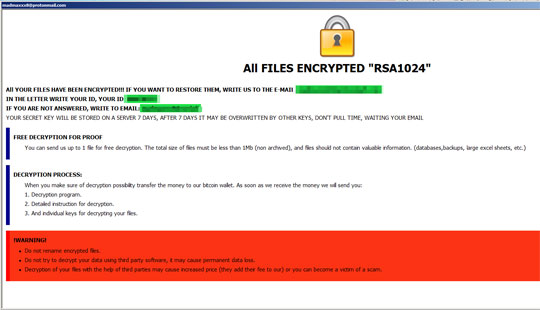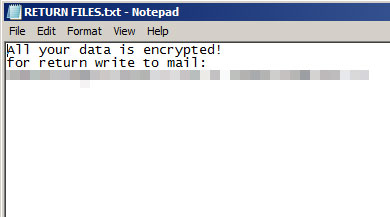Ransom.Win32.CRYSIS.TIBGGQ
Trojan-Ransom.Win32.Crusis.to (Kaspersky), Ransom:Win32/Wadhrama (Microsoft)
Windows


Threat Type: Ransomware
Destructiveness: No
Encrypted:
In the wild: Yes
OVERVIEW
This Ransomware arrives on a system as a file dropped by other malware or as a file downloaded unknowingly by users when visiting malicious sites.
It encrypts files with specific file extensions. It drops files as ransom note.
TECHNICAL DETAILS
Arrival Details
This Ransomware arrives on a system as a file dropped by other malware or as a file downloaded unknowingly by users when visiting malicious sites.
Installation
This Ransomware drops the following copies of itself into the affected system:
- %System%\{Malware Name}
(Note: %System% is the Windows system folder, where it usually is C:\Windows\System32 on all Windows operating system versions.)
It adds the following processes:
- cmd.exe mode con cp select=1251
- vssadmin delete shadows /all /quiet
- mshta.exe "%User Startup%\Info.hta"
- mshta.exe "%Common Startup%\Info.hta"
(Note: %User Startup% is the current user's Startup folder, which is usually C:\Windows\Profiles\{user name}\Start Menu\Programs\Startup on Windows 98 and ME, C:\WINNT\Profiles\{user name}\Start Menu\Programs\Startup on Windows NT, C:\Documents and Settings\{User name}\Start Menu\Programs\Startup on Windows 2003(32-bit), XP and 2000(32-bit), or C:\Users\{user name}\AppData\Roaming\Microsoft\Windows\Start Menu\Programs\Startup on Windows Vista, 7, 8, 8.1, 2008(64-bit), 2012(64-bit), 10(64-bit).. %Common Startup% is the startup folder for all users, which is usually C:\Documents and Settings\All Users\Start Menu\Programs\Startup on Windows 2000, XP, and Server 2003, or C:\ProgramData\Microsoft\Windows\Start Menu\Programs\Startup on Windows Vista, 7, and 8.)
Autostart Technique
This Ransomware adds the following registry entries to enable its automatic execution at every system startup:
HKEY_LOCAL_MACHINE\SOFTWARE\Microsoft\
Windows\CurrentVersion\Run
{Malware Name} = %System%\{Malware Name}
HKEY_LOCAL_MACHINE\SOFTWARE\Microsoft\
Windows\CurrentVersion\Run
%System%\Info.hta = mshta.exe "%System%\Info.hta"
HKEY_LOCAL_MACHINE\SOFTWARE\Microsoft\
Windows\CurrentVersion\Run
%Application Data%\Info.hta = mshta.exe "%Application Data%\Info.hta"
It drops the following file(s) in the Startup Items folder to enable its automatic execution at every system startup:
- %User Startup%\{Malware Name}
- %Common Startup%\{Malware Name}
(Note: %User Startup% is the current user's Startup folder, which is usually C:\Windows\Profiles\{user name}\Start Menu\Programs\Startup on Windows 98 and ME, C:\WINNT\Profiles\{user name}\Start Menu\Programs\Startup on Windows NT, C:\Documents and Settings\{User name}\Start Menu\Programs\Startup on Windows 2003(32-bit), XP and 2000(32-bit), or C:\Users\{user name}\AppData\Roaming\Microsoft\Windows\Start Menu\Programs\Startup on Windows Vista, 7, 8, 8.1, 2008(64-bit), 2012(64-bit), 10(64-bit).. %Common Startup% is the startup folder for all users, which is usually C:\Documents and Settings\All Users\Start Menu\Programs\Startup on Windows 2000, XP, and Server 2003, or C:\ProgramData\Microsoft\Windows\Start Menu\Programs\Startup on Windows Vista, 7, and 8.)
Process Termination
This Ransomware terminates the following services if found on the affected system:
- FirebirdGuardianDefaultInstance
- FirebirdServerDefaultinstance
- Sqlwriter
- Mssqlserver
- Sqlserveradhelper
It terminates the following processes if found running in the affected system's memory:
- 1c8.exe
- 1cv77.exe
- Outlook.exe
- Postgres.exe
- Mysqld-nt.exe
- Mysqld.exe
- Sqlservr.exe
Other Details
This Ransomware does the following:
- Executes %Common Startup%\Info.hta & %User Startup%\info.hta as ransom note

Ransomware Routine
This Ransomware encrypts files with the following extensions:
- .1cd
- .3ds
- .3fr
- .3g2
- .3gp
- .7z
- .accda
- .accdb
- .accdc
- .accde
- .accdt
- .accdw
- .adb
- .adp
- .ai
- .ai3
- .ai4
- .ai5
- .ai6
- .ai7
- .ai8
- .anim
- .arw
- .as
- .asa
- .asc
- .ascx
- .asm
- .asmx
- .asp
- .aspx
- .asr
- .asx
- .avi
- .avs
- .backup
- .bak
- .bay
- .bd
- .bin
- .bmp
- .bz2
- .c
- .cdr
- .cer
- .cf
- .cfc
- .cfm
- .cfml
- .cfu
- .chm
- .cin
- .class
- .clx
- .config
- .cpp
- .cr2
- .crt
- .crw
- .cs
- .css
- .csv
- .cub
- .dae
- .dat
- .db
- .dbf
- .dbx
- .dc3
- .dcm
- .dcr
- .der
- .dib
- .dic
- .dif
- .divx
- .djvu
- .dng
- .doc
- .docm
- .docx
- .dot
- .dotm
- .dotx
- .dpx
- .dqy
- .dsn
- .dt
- .dtd
- .dwg
- .dwt
- .dx
- .dxf
- .edml
- .efd
- .elf
- .emf
- .emz
- .epf
- .eps
- .epsf
- .epsp
- .erf
- .exr
- .f4v
- .fido
- .flm
- .flv
- .frm
- .fxg
- .geo
- .gif
- .grs
- .gz
- .h
- .hdr
- .hpp
- .hta
- .htc
- .htm
- .html
- .icb
- .ics
- .iff
- .inc
- .indd
- .ini
- .iqy
- .j2c
- .j2k
- .java
- .jp2
- .jpc
- .jpe
- .jpeg
- .jpf
- .jpg
- .jpx
- .js
- .jsf
- .json
- .jsp
- .kdc
- .kmz
- .kwm
- .lasso
- .lbi
- .lgf
- .lgp
- .log
- .m1v
- .m4a
- .m4v
- .max
- .md
- .mda
- .mdb
- .mde
- .mdf
- .mdw
- .mef
- .mft
- .mfw
- .mht
- .mhtml
- .mka
- .mkidx
- .mkv
- .mos
- .mov
- .mp3
- .mp4
- .mpeg
- .mpg
- .mpv
- .mrw
- .msg
- .mxl
- .myd
- .myi
- .nef
- .nrw
- .obj
- .odb
- .odc
- .odm
- .odp
- .ods
- .oft
- .one
- .onepkg
- .onetoc2
- .opt
- .oqy
- .orf
- .p12
- .p7b
- .p7c
- .pam
- .pbm
- .pct
- .pcx
- .pdd
- .pdp
- .pef
- .pem
- .pff
- .pfm
- .pfx
- .pgm
- .php
- .php3
- .php4
- .php5
- .phtml
- .pict
- .pl
- .pls
- .pm
- .png
- .pnm
- .pot
- .potm
- .potx
- .ppa
- .ppam
- .ppm
- .pps
- .ppsm
- .ppt
- .pptm
- .pptx
- .prn
- .ps
- .psb
- .psd
- .pst
- .ptx
- .pub
- .pwm
- .pxr
- .py
- .qt
- .r3d
- .raf
- .rar
- .raw
- .rdf
- .rgbe
- .rle
- .rqy
- .rss
- .rtf
- .rw2
- .rwl
- .safe
- .sct
- .sdpx
- .shtm
- .shtml
- .slk
- .sln
- .sql
- .sr2
- .srf
- .srw
- .ssi
- .st
- .stm
- .svg
- .svgz
- .swf
- .tab
- .tar
- .tbb
- .tbi
- .tbk
- .tdi
- .tga
- .thmx
- .tif
- .tiff
- .tld
- .torrent
- .tpl
- .txt
- .u3d
- .udl
- .uxdc
- .vb
- .vbs
- .vcs
- .vda
- .vdr
- .vdw
- .vdx
- .vrp
- .vsd
- .vss
- .vst
- .vsw
- .vsx
- .vtm
- .vtml
- .vtx
- .wb2
- .wav
- .wbm
- .wbmp
- .wim
- .wmf
- .wml
- .wmv
- .wpd
- .wps
- .x3f
- .xl
- .xla
- .xlam
- .xlk
- .xlm
- .xls
- .xlsb
- .xlsm
- .xlsx
- .xlt
- .xltm
- .xltx
- .xlw
- .xml
- .xps
- .xsd
- .xsf
- .xsl
- .xslt
- .xsn
- .xtp
- .xtp2
- .xyze
- .xz
- .zip
It avoids encrypting files with the following strings in their file name:
- boot.ini
- bootfont.bin
- ntldr
- ntdetect.com
- io.sys
- Info.hta
- {Malware Filename}.exe
- RETURN FILES.txt
It avoids encrypting files with the following strings in their file path:
- %Windows%
(Note: %Windows% is the Windows folder, where it usually is C:\Windows on all Windows operating system versions.)
It appends the following extension to the file name of the encrypted files:
- .id-{Generated ID}.[madmaxxx8@protonmail.com].bat
It drops the following file(s) as ransom note:
- %Desktop%\RETURN FILES.txt
- {Encrypted Drive}\RETURN FILES.txt

- %System%\Info.hta
- %Application Data%\Info.hta
- %Common Startup%\Info.hta
- %User Startup%\info.hta
SOLUTION
Step 1
Trend Micro Predictive Machine Learning detects and blocks malware at the first sign of its existence, before it executes on your system. When enabled, your Trend Micro product detects this malware under the following machine learning name:
-
Troj.Win32.TRX.XXPE50FFF036
Step 2
Before doing any scans, Windows 7, Windows 8, Windows 8.1, and Windows 10 users must disable System Restore to allow full scanning of their computers.
Step 3
Note that not all files, folders, and registry keys and entries are installed on your computer during this malware's/spyware's/grayware's execution. This may be due to incomplete installation or other operating system conditions. If you do not find the same files/folders/registry information, please proceed to the next step.
Step 4
Identify and terminate files detected as Ransom.Win32.CRYSIS.TIBGGQ
- Windows Task Manager may not display all running processes. In this case, please use a third-party process viewer, preferably Process Explorer, to terminate the malware/grayware/spyware file. You may download the said tool here.
- If the detected file is displayed in either Windows Task Manager or Process Explorer but you cannot delete it, restart your computer in safe mode. To do this, refer to this link for the complete steps.
- If the detected file is not displayed in either Windows Task Manager or Process Explorer, continue doing the next steps.
Step 5
Delete this registry value
Important: Editing the Windows Registry incorrectly can lead to irreversible system malfunction. Please do this step only if you know how or you can ask assistance from your system administrator. Else, check this Microsoft article first before modifying your computer's registry.
- In HKEY_LOCAL_MACHINE\SOFTWARE\Microsoft\
- Windows\CurrentVersion\Run
- {Malware Name} = %System%\{Malware Name}
- Windows\CurrentVersion\Run
- In HKEY_LOCAL_MACHINE\SOFTWARE\Microsoft\
- Windows\CurrentVersion\Run
- %System%\Info.hta = mshta.exe %System%\Info.hta
- Windows\CurrentVersion\Run
- In HKEY_LOCAL_MACHINE\SOFTWARE\Microsoft\
- Windows\CurrentVersion\Run
- %Application Data%\Info.hta = mshta.exe %Application Data%\Info.hta
- Windows\CurrentVersion\Run
Step 6
Search and delete these files
- %User Startup%\{Malware Name}
- %Common Startup%\{Malware Name}
- %Application Data%\Info.hta
- %User Startup%\Info.hta
- %Common Startup%\Info.hta
- %System%\Info.hta
- %System%\{Malware Name}
Step 7
Scan your computer with your Trend Micro product to delete files detected as Ransom.Win32.CRYSIS.TIBGGQ. If the detected files have already been cleaned, deleted, or quarantined by your Trend Micro product, no further step is required. You may opt to simply delete the quarantined files. Please check the following Trend Micro Support pages for more information:
Did this description help? Tell us how we did.

